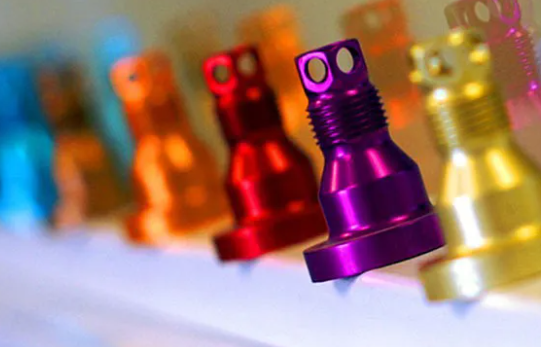Anodizing is a common surface treatment method, often used on materials such as aluminum and aluminum alloys. The 720 rule of anodizing refers to the relationship between the thickness of the anodized film and the surface area of the film during the oxidation process. Specifically, the rule states that under conventional sulfuric acid anodizing conditions, the film thickness is approximately 720 times the film surface area.

How Does Anodizing Implement the 720 Rule
To implement the 720 rule in anodizing, it is first necessary to prepare a proper electrolytic cell and electrolyte. A common electrolyte is sulfuric acid, which contains a certain concentration and temperature. The aluminum or aluminum alloy piece is then placed in the electrolytic cell as the anode and another larger piece of aluminum is placed inside it as the cathode. The oxidation process is achieved by applying an electric current and controlling the electrolysis time. During this process, an anodized film is formed on the aluminum surface with a thickness to the surface area that complies with the 720 rule.
What Are the Benefits of the 720 Rule in Anodizing
The Anodized 720 rule offers the following benefits:
- – Thickness consistency: According to the rule, the thickness of the anodized film is proportional to the surface area, which makes it possible to obtain a relatively consistent film thickness on large-area aluminum parts.
- -Control accuracy: By following the 720 rule, the thickness of the anodized film can be better controlled and predicted, making the production process more reliable and precise.
- – Surface quality: Anodized film has good corrosion resistance and hardness, which can provide good surface protection and decorative effect.
What Is the Formula for the 720 Rule in Anodizing
The formula for the anodizing 720 rule can be expressed as:
Film thickness (μm) = 720 / surface area (cm²)
Wherein, the film thickness is in microns, and the surface area is in square centimeters.
Why Is the 720 Rule Important for Anodizing
The 720 rule is important for anodizing because it provides a simple and effective method to control and predict the thickness of anodized films. By following this rule, manufacturers can better plan and design products and ensure consistent film thicknesses to meet product requirements and specifications.
What Are the Limitations of the Anodizing 720 Rule
The 720 rule provides a way to estimate film thickness when using a constant current anodizing process, but it does have limitations. Here are some other examples illustrating the limitations of the 720 rule:
- – High-alloy aluminum: High-alloy aluminum, such as 2024 and 7075 alloys, has complex chemical composition and microstructure. Other alloying elements in these alloys (such as copper, zinc, etc.) may have an impact on the anodic oxidation process and film thickness formation, making the 720 rule inapplicable. These alloys often require experimentation and testing to determine the appropriate anodizing parameters for them.
- -Other materials: The 720 rule is mainly applicable to aluminum alloys, for other materials such as titanium, etc., the rule does not apply. Different materials have different chemical properties and oxidation behavior, thus requiring specific anodizing processes and parameters.
- -Temperature effect: The temperature you mentioned does have an effect on anodizing time, and the 720 rule doesn’t take the temperature effect into account. Temperature can affect the solubility and reaction rate of the electrolyte, thereby affecting the growth rate and quality of the oxide film. Therefore, at different temperatures, the anodizing time may vary.
What Are the Standard Anodizing Controls for Rule 720
Standard anodizing control is a quality control method based on the 720 rule, designed to ensure that the thickness of anodized film meets the specification requirements. The specific control steps include:
- -Choose the right electrolyzer and electrolyte: According to the specific materials and requirements, choose the appropriate electrolyzer and electrolyte to ensure a stable and consistent oxidation effect.
- – Determine the appropriate electrolysis parameters: according to the specific material and product requirements, determine the appropriate parameters such as current density, electrolysis time, and temperature. The choice of these parameters should be optimized based on experience and experimental data to achieve the desired film thickness.
- – Control electrolysis time: According to the 720 rule, calculate the required electrolysis time according to the required film thickness. During the operation, the electrolysis time is strictly controlled to ensure that the film thickness conforms to the specification.
- -Monitoring of film thickness: Regularly monitor and check the thickness of the anodized film using suitable measuring equipment, such as a film thickness gauge. According to the measurement results, make necessary adjustments and corrections to ensure that the film thickness meets the specification requirements.
Do the 720 Rules for Anodizing Apply to All Types of Aluminum Alloys
The 720 rules for anodizing generally apply to most aluminum alloys, but not to all types of aluminum alloys. Different types of aluminum alloys may have different alloy compositions and microstructures, so their oxidation behavior may also be different. The presence of specific alloying elements and additives may affect the growth rate and formation characteristics of the oxide film during anodizing, making Rule 720 inapplicable to these alloys. In addition, special treatments and alloy adjustments can also alter the oxidation behavior of aluminum alloys, making Rule 720 inapplicable. For example, through pretreatment, adding specific additives, or using special processes, the formation rate and thickness of the oxide film can be changed so that it does not exactly match the 720 rule. Therefore, in practical applications, for specific types of aluminum alloys, especially alloys with higher alloying degrees or with special additives, experiments, and tests may be required to determine the oxidation behavior and control rules applicable to the alloy.